ISSN ONLINE(2319-8753)PRINT(2347-6710)
ISSN ONLINE(2319-8753)PRINT(2347-6710)
H. Taouda 1, 2*, R. Chabir1, F. Errachidi1,3, L. Aarab 2
|
| Related article at Pubmed, Scholar Google |
Visit for more related articles at International Journal of Innovative Research in Science, Engineering and Technology
The present study investigates the correlation between phenolic, Flavonoid compound content and antioxidant activity of date fruits. Phenolic content values range from 1.5 to 4.5 mg /100 g fresh weight exprimed as Galic acid equivalent (GAE). Total flavonoids content (TFC) of studied date varies significantly (p < 0.05) from 0.010mg to 0.38 mg/100g fresh weight exprimed as quercetin equivalents (QE). The antioxidant activity of methanol extract evaluated using the DPPH method, and examined by comparison to controls (BHT and Vitamin C). The highest inhibition of oxidation was attained in Bouskri variety, which was 88.88% at 40μg/mL concentration of phenolic compounds. Correlation (R2) between Phenolic compound content and antioxidant activity range from 0,8 to 0,9. However lower correlation was obtained in Deglet Baida variety with (R2 = 0.6). The high correlation coefficient indicates that phenolics are one of the main compounds responsible for the scavenging effect of date varieties. The date fruit could be a good source of antioxidants, which may have healthy benefits for humans.
Keywords |
| Date, Phenolic compound, flavonoids content and antioxidant activity. |
INTRODUCTION |
| In recent years, increasing attention has been pointing to the role of diet in human health. Epidemiological studies have shown that high fruit and vegetable consumption has health benefits in the prevention of chronic diseases[1]such as coronary heart disease (CHD), cardiovascular disease (CVD), cancers, aging, atherosclerosis, neurodegenerative diseases “Parkinson and Ahlzeimer”[2] inflammation, and problems caused by cell and cutaneous aging [3-8].Palm date fruit (Phoenix dactylifera L) is an important trophic source for desertic Moroccan population, where it is considered as vital component of their daily diet. The Arabic terms of stages ripening “Kimri, Khalal, Rutab and Tamar” were used to represent, respectively, the immature green, the mature full colored, the soft brown and the hard raisin-like stages of development [9-10]. In Morocco, dates are consumed at Tamar stage where it have good storability, sweety taste and lower astringency. The chemical composition of date fruits was reported in many studies [11]. These fruit are rich in simple sugars like glucose and fructose (65-80%), and represent a good source of fibers (6,4-11,5%) as well as some essential minerals (0,10-916mg/100g dry weight).In addition, dates are characterized by a low fat content (0,2- 0,5%). Besides nutritional value, date fruits are rich in phytochemicals such as phenolic compounds. Recently, several studies have reported such activity of date fruits from Algeria, Kuwait, Oman and the USA. An antioxidant, which can quench reactive free radicals, can prevent the oxidation of other molecules and may, therefore, have health-promoting effects in the prevention of degenerative diseases [12]. The interest in antioxidants has been increasing because of their high capacity in scavenging free radicals related to various diseases [13]. |
| The antioxidant potentials of Algerian dates have been studied [14], the total phenolic compounds (TPC) and antiradical efficiency of the Algerian ripe date palm fruits were 2.49 - 8.36 mg gallic acid equivalents (GAE) per 100 g fresh weight and 0.08-0.22 mg/100g, respectively. Little information has been published about the phenolic acid, flavonoid compositions and antioxidant capacities of Moroccan date cultivars. Thus, further studies were deemed necessary in order to characterize the distribution and content of phenolic compound and their contribution to the antioxidant capacity of Moroccan date cultivars. Such detailed information is essential in order to advance the existing knowledge and to promote the use of these cultivars. |
MATERIALS AND METHODS |
| II.1 Date fruit collection |
| Dates samples varieties was obtained from the wholesale market in Fez city of Morocco, local dates varieties are Abourar, Bouskri, Klane, Mejhoul, Khalt, Rassltmer, Tarzawa, Jihel, Boufeggous, Bouslikhènes, the imported date varieties are Deglet Nour, Deglet Baida and Lulu. The samples were scelled separately in aseptic packages and transported in icebox to laboratory. Thereafter, samples are stored at 4°C until analysis. |
| II.2Preparation of methanol extract |
| 10g of date was extracted by shaking at 150 rpm for 24 h with 100 ml methanol (80%) and filtered through filter paper No 1. The filtrate designated as methanol extract. The experiment was performed at triplicate |
| II.3Estimation of the phenolic content |
| The total phenolic content was estimated using Folin- Ciocalteu (FC) assay which is widely used in routine analysis [15]. Briefly, 0.16 ml (three replicates) of the extracts diluted in distilled water was mixed with 0.16ml of Folin- Ciocalteu reagent. After 5min, 1.6 ml of 7% sodium carbonate were added. The absorbance of the resulting bluecolored solution was measured at 750 nm after 90 min with intermittent shaking. Quantitative measurements were performed, based on a standard calibration curve of point from 0 to 0.5mg/ml of Gallic acid in methanol. The total phenolic content was expressed as Gallic acid (GAE) in mg/100g of extract. |
| II.4 Determination of Total Flavonoid |
| The total flavonoid content was determined using the method as adapted by Arvouet- Grand et al. [16]. 1.0 ml of 2% aluminum trichloride (AlCl3, 6H2O) in methanol was mixed with the same volume of the extract solution. Absorption readings at 430 nm using Perkin Elmer UV-VIS spectrophotometer were taken after 10min against a blank sample consisting of extract solution with 1.0 ml methanol without AlCl3.The total flavonoid content is expressed as mg of Quercetin equivalents per gram of sample |
| II.5 Evaluation of antioxidant activity |
| Antioxidant activity was evaluated by Scavenging Radical activity using2.2-Diphenyl-2-picryl hydrazyl radical method (DPPH) was adapted from protocol of Hanato [17] with some modifications. Each sample stock solution (0.2mg/ml) was diluted to final concentrations of 0.01, 0.02, 0.03, 0.04 mg/ml, in methanol, and 0.5 Mm DPPH methanol solution. Sampls solution of different concentrations was allwed to stand at room temperature in the dark. After 30min, the decrease in absorbance at 517 nm was measured. The radical scavenging activities of the samples, expressed as percentage inhibition of DPPH, were calculated according to the formula |
| A0 is the absorbance of the control reaction, and A1 is the absorbance of the extract. The synthetic antioxidant reagent BHT and Ascorbic acid (Vitamin C) were used as the positive control. The extract concentration providing 50% of antioxidant activities (IC50) was calculated using the graph by plotting inhibition percentage against extract concentration [18]. The tests were carried out in triplicate. |
| II.6 Statistical analysis |
| All values are the means of three independent experiments presented as mean ± standard deviation (X ± SD). The Tukey’s test and one-way analysis of variance (ANOVA 1) were used to compare results with α=5%. |
RESULTS AND DISCUSSION |
| III. 1 Total phenolic content |
| Total phenolics compounds in date extracts are determined using the Folin-Ciocalteu assay and expressed as Gallic acid equivalents (GAE). Total phenolic content ranged from 1.5 to 4.5 mg of GAE /100 g fresh weight basis (Figure 1). Boufeggous variety had the higher amount of total phenolic (4.5 mg of GAE /100 g fresh weight basis), followed by Tarzawa (3.6 mg of GAE /100 g), Bouskri (3.4 mg of GAE /100 g), Deglet Baida (3.3 mg of GAE /100 g), Lulu (3.2 mg of GAE /100 g), Mejhoul (2.6 mg of GAE /100 g), Jihel (2.6 of GAE /100 g), Deglet Nour (2.5 of GAE /100 g), Rassltmer (2.4 of GAE /100 g), Klane and Abourar (1.8 of GAE /100 g), Bouslikhène (1.6 of GAE /100 g). Khalt variety showed the lowest level of total phenolics content (1.5 of GAE /100 g). Mansouri et al.[14] who studied seven Algerian date palm fruits and Biglari [19] who studied Iranian date’s fruits reported similar results for total phenolic contents (2.49 - 8.36 mg GAE/ 100g for Algerian date fruits and 2.89-6.41 mg GAE / 100g for Iranian varieties). However Al-Farsi et al. [20] found much higher total phenolic contents ranged from172 to 246 mg of GAE/ 100 mg fresh weight for Omani dates. Wu et al. [21] reported of total phenolic for tow date cultivars studied (572 and 661 mg of GAE/100 mg fresh weight). These variations in total phenolic contents could be related to various factors. One such factor may be the difference of genetic potential of individual cultivars for polyphenol biosynthesis [22]. Maturity, season, geographic origin, fertilizer, soil type, storage conditions and amount of sunlight received may also be critical in this respect [20]. |
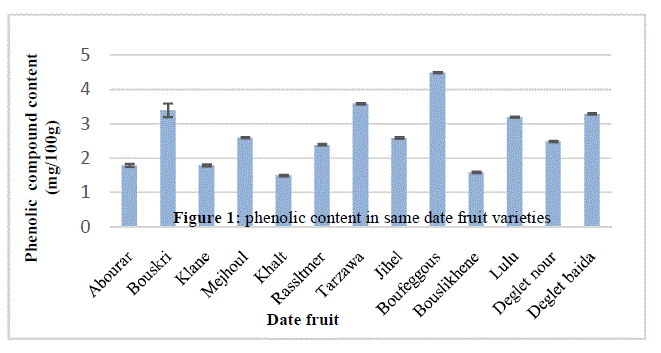 |
| Total flavonoids content (TFC) (Figure 2) of studied dates varied significantly (p < 0.05) from 0.010mg to 0.38 mg (QE)/100g fresh weight. The minimum value was obtained from Deglet Baida and Deglet Nour date (0.01mg (QE)/ 100g). The maximum value was obtained from Abouar date (0.38 mg (QE)/ 100g). |
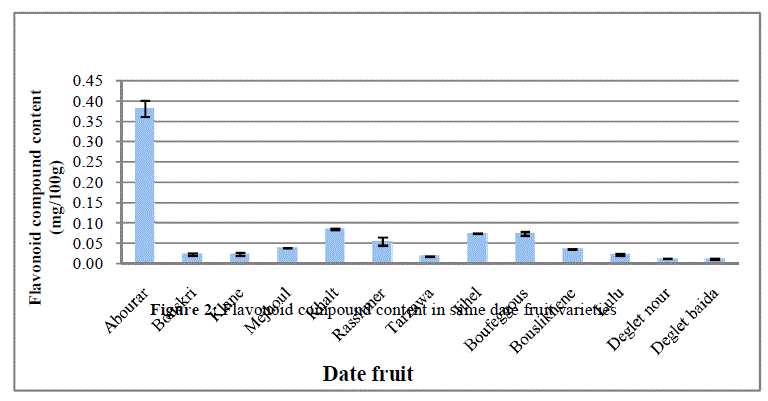 |
| These values were lower than those reported by Al-Farsi et al. [11], which found the total flavonoid content ranges between 167 mg to 343 mg GAE/100 gm fresh weight of Omani dates. Hasnaoui [23] found in their study that total flavonoid of Moroccan date arranged from 43.28 to 84.95 mg (QE)/100g dry weight. The differences between their results [11, 23], are linked to the yield references according to fresh or dry weight. Despite that, our dates belong clearly to lower phenolic compounds content varieties. |
| III. 3 Antioxidant activity of date extract |
| The antioxidant activity of methanol extract of these date varieties was evaluated using the DPPH method, and examined by comparing it to controls (BHT and Vitamin C). The highest inhibition of oxidation was attained by Bouskri variety extract (88.88%) and was followed respectively at the same concentration of phenolic compounds (0.04 mg/mL) by Boufeggous (85.12%), Deglet Baida (84.26%), Bouslikhène (83%), Khalt (82.97%), Tarzawa (81.48%), Abourar and klane (80.63%), lulu (80.49%), Rassltmer (77.46%), Deglet Nour (67.29%), Jihel and Mejhoul varieties showed the lowest level of antioxidant activity (66.96%) ( Figure 3). |
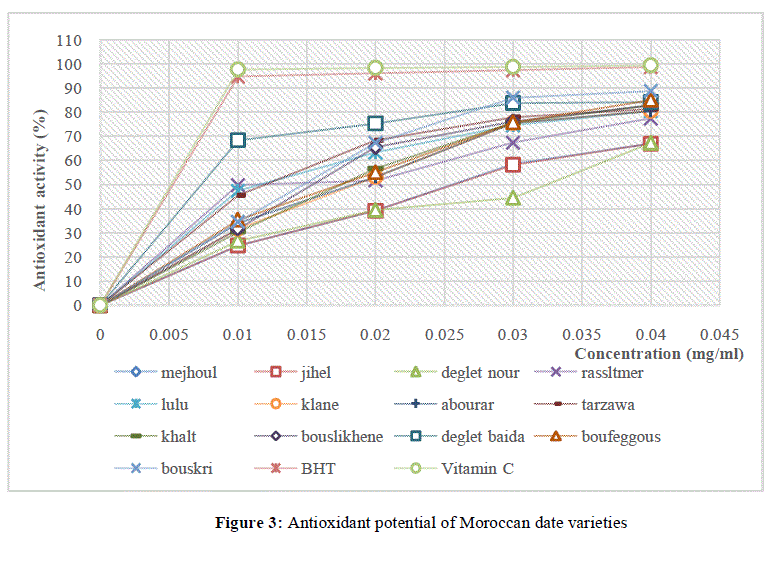 |
| Kchaou [24] Found similar result which DPPH free radical scavenging activities ranged from 57.54% to 90.12%. However Khanavi [25] reported in their studies on Iranian date, that the higher amount of antioxidant power was 56.61%. This value is lower than that obtained in our study. The antioxidant activities of controls (BHT and Vitamin C) are respectively 98.71% and 99.45% at the same concentration (0.04 mg/mL). It can be noted that our varieties presents a good antioxidant activity in comparison to controls. |
| The experimental data revealed that antioxidant activity of date is proportional to phenolic compounds concentration.. Table 1 presents the IC50 values of the studied date; Deglet Baida variety has a lower value of IC50, which has strong antioxidant activity. So we noticed that the lower IC50 value reflects better protective action. Liolios and al., [26] found in their study the value 17 mg/ml as IC50. Another parameter that expresses anti-radical power was calculated from the first parameter (IC50) which is noted "EA" (Efficacity anti-radical, equal to 1/IC50). EA values of all methanolic extracts are significant. Moreover, these values are larger, more anti-radical power is high (Table1) |
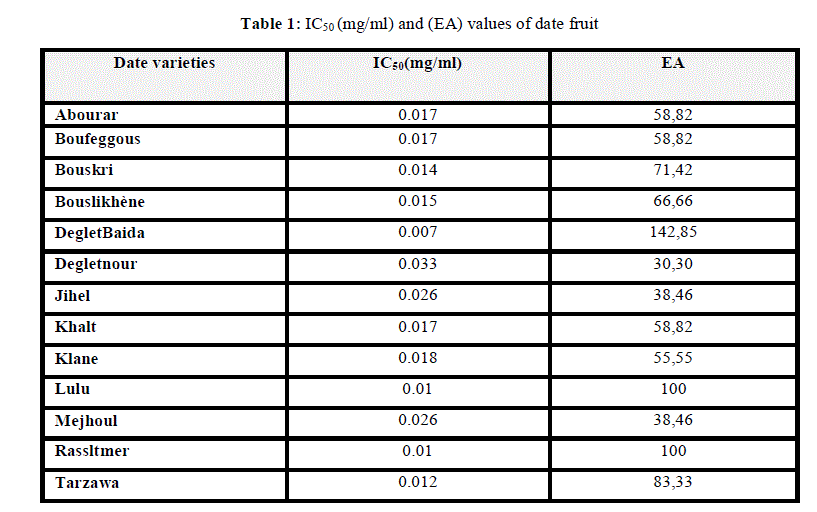 |
| In order to investigate the relationship between phenolic compounds content and anti-radical activity of date fruit, we were prompted to study the date profile of these parameters. The variance analysis showed a significant difference between dates phenolic contents and Antioxidant activity (table 2). |
 |
| The comparison of averages performed by the Tukey test (table 3) confirms that the difference between averages is significant and dates are grouped as they have same values of the anti-radical activity/ phenolic compound content. The correlation analysis between DPPH radical scavenging activities of various dates and total phenolic contents is fundamental for the evaluation of parameter effects on antioxidant activity. Phenolic content and antioxidant activity correlation (R2) range from 0.8 to 0.9. However lower correlation was obtained in Deglet Baida variety with R2 = 0.6. The high correlation coefficient indicates that phenolic is one of the main compounds responsible for the scavenging effect of date varieties (Table 3). |
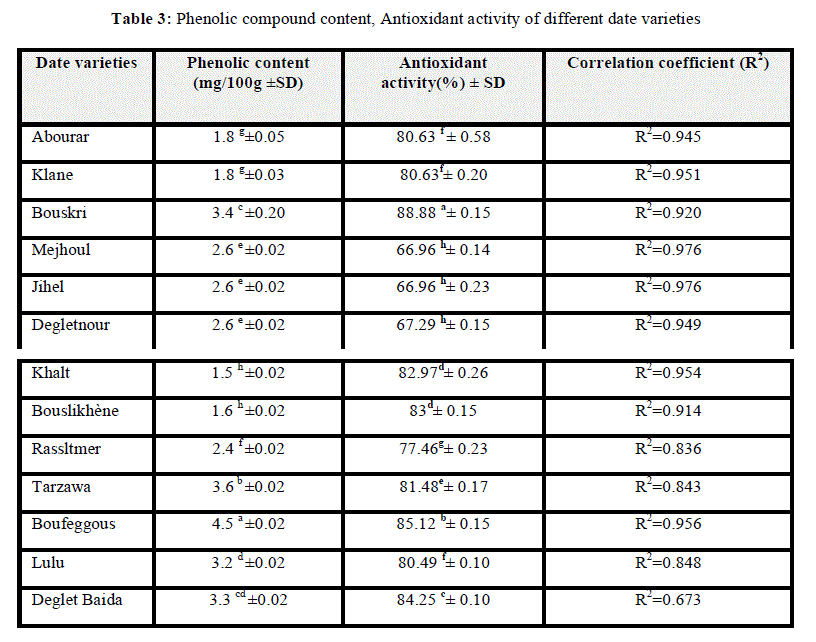 |
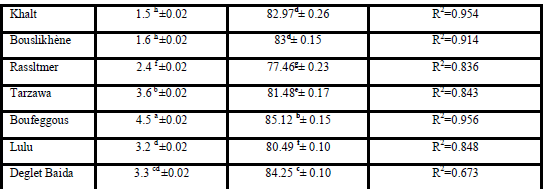 |
| The average values in the same column, followed by the same letter or letters (a or b or c….cd), are not statistically different (P < 0.05) as measured by Tukey’s test. As example Abourar and Klane date varieties belong to the same group according to phenolic content column and Antioxidant activity column. |
CONCLUSION |
| The antioxidant activities of Moroccan dates were determined and total phenolic and flavanoid contents were also analysed. Over all, Bouskri variety showed maximum antioxidant capability in all tested assays and Boufeggous showed higher phenolic contents. Furthermore, it can be concluded that all of these methanolic date extracts had strong antioxidant activity and radical scavenging activities in comparison to controls (BHA and Vitamin C). Date fruit can be a source of plant antioxidants, with a potential use in food, cosmetics and pharmaceutical fields. The phenolic compounds might be the major active component responsible for the strong antioxidant activity. |
References |
|